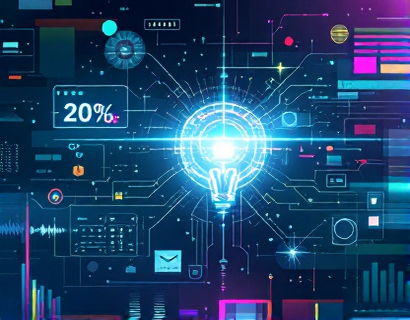Pioneering Enhanced Digital Experiences Through Advanced Ucosystem Solutions
The intersection of cryptocurrency and artificial intelligence (AI) is giving rise to a new era of digital innovation, where connectivity, growth, and user satisfaction are being redefined. This fusion is not just about combining two cutting-edge technologies but about creating a seamless and enhanced digital experience that was previously unimaginable. As we delve into this topic, we will explore how these technologies are transforming user engagement and driving innovation in the tech ecosystem.
The concept of a digital ecosystem powered by cryptocurrency and AI is built on the foundation of decentralization and intelligence. Cryptocurrency, with its inherent properties of security, transparency, and decentralization, provides a robust framework for transactions and data management. AI, on the other hand, brings in the capability to analyze vast amounts of data, learn from patterns, and make intelligent decisions. When these two are combined, the potential for creating advanced solutions that enhance digital experiences becomes vast.
Enhancing Connectivity Through Blockchain and AI
One of the most significant impacts of this fusion is the enhancement of connectivity in the digital world. Blockchain technology, the backbone of cryptocurrency, ensures secure and transparent transactions without the need for intermediaries. AI can optimize these transactions by predicting patterns, reducing latency, and improving the overall efficiency of the network. For instance, AI algorithms can be used to manage network congestion, ensuring that transactions are processed swiftly and reliably.
Moreover, AI-driven identity verification systems can integrate with blockchain to provide secure and seamless user authentication. This not only enhances the security of digital interactions but also simplifies the user experience. Users can enjoy a more connected and secure digital environment, where their identities are verified instantly and their data is protected by the immutable nature of blockchain.
Driving Growth with Intelligent Solutions
The integration of AI in cryptocurrency ecosystems is not just about improving existing processes; it's about driving growth through innovative solutions. AI can analyze market trends, predict price movements, and provide insights that can be invaluable for investors and traders. Smart contracts, powered by AI, can automate complex financial transactions, reducing the need for manual intervention and minimizing the risk of errors.
Furthermore, AI can enhance the development of decentralized applications (dApps) by providing intelligent and adaptive user interfaces. These dApps can offer personalized experiences based on user behavior and preferences, thereby increasing user engagement and satisfaction. The combination of AI and blockchain can also facilitate the creation of new business models, such as decentralized finance (DeFi) platforms, which offer a range of financial services without traditional intermediaries.
Personalization and User Satisfaction
One of the most transformative aspects of this technology fusion is the ability to deliver highly personalized digital experiences. AI algorithms can analyze user data to understand preferences, behaviors, and needs, allowing for tailored recommendations and services. In the context of cryptocurrency and blockchain, this means that users can interact with dApps and services that are specifically designed to meet their unique requirements.
For example, AI can optimize the user interface of a cryptocurrency wallet based on the user's frequency of transactions, preferred cryptocurrencies, and security settings. This level of personalization not only enhances the user experience but also increases the likelihood of user retention and loyalty. Satisfied users are more likely to engage with the ecosystem, recommend services to others, and contribute to the overall growth of the platform.
Security and Trust through AI and Blockchain
Security is a paramount concern in the digital world, and the combination of AI and blockchain offers robust solutions to enhance trust and security. AI can detect and mitigate potential security threats in real-time by analyzing patterns and anomalies in data. This proactive approach can prevent fraud, hacking, and other malicious activities, ensuring that the digital ecosystem remains safe for users.
Blockchain's immutable ledger, combined with AI's predictive capabilities, creates a nearly unhackable system. Transactions are recorded in a transparent and verifiable manner, reducing the risk of fraud and increasing trust among users. This trust is crucial for the adoption and growth of cryptocurrency and AI-powered solutions, as it reassures users that their data and assets are secure.
Innovative Use Cases and Future Potential
The potential applications of AI and blockchain in creating advanced digital experiences are vast and varied. In the realm of gaming, AI can enhance the realism and interactivity of blockchain-based games, while blockchain ensures fair and transparent gameplay. In the healthcare sector, AI can analyze medical data stored on a blockchain to provide personalized treatment recommendations, while ensuring patient data privacy and security.
In the realm of supply chain management, AI can optimize logistics and inventory management using blockchain for transparent and tamper-proof tracking. This not only improves efficiency but also builds trust among all parties involved. The combination of these technologies can revolutionize industries by providing transparent, secure, and intelligent solutions.
Challenges and Considerations
While the potential of AI and blockchain in enhancing digital experiences is immense, there are challenges that need to be addressed. Scalability remains a significant issue for blockchain technology, as the current infrastructure may struggle to handle the high volume of transactions required for widespread adoption. AI algorithms also require large amounts of data to train effectively, raising concerns about data privacy and ethical use.
Moreover, the regulatory landscape for cryptocurrency and AI is still evolving, and compliance with varying regulations across different regions can be complex. However, these challenges are not insurmountable and are being actively addressed by researchers, developers, and policymakers.
Conclusion
The fusion of cryptocurrency and AI is paving the way for a new era of digital innovation, where connectivity, growth, and user satisfaction are at the forefront. By leveraging the strengths of both technologies, we can create advanced solutions that not only enhance the digital experience but also drive meaningful change in various industries. As this field continues to evolve, it is essential to stay informed and embrace the opportunities that this powerful combination offers.










































